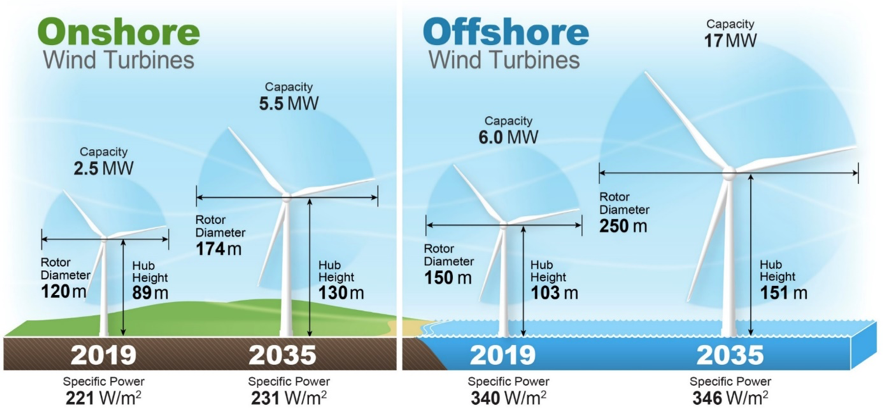Offshore Wind Costs: Are Projects Too Expensive For Energy Companies?

Table of Contents
The global push for renewable energy is driving significant investment in offshore wind farms, a sector poised for explosive growth. However, the hefty price tag associated with these projects is raising serious concerns about their viability for energy companies. Offshore wind costs are a major factor influencing the feasibility of these ambitious undertakings, impacting investment decisions and the overall trajectory of the renewable energy transition. This article will examine the various cost components of offshore wind projects, analyze current trends, and discuss the potential for future cost reduction.
<h2>High Initial Capital Expenditure (CAPEX) of Offshore Wind Farms</h2>
Offshore wind projects require substantial upfront investment, making CAPEX a significant hurdle for energy companies. The sheer scale and complexity of these projects contribute to their high cost. Let's break down the key CAPEX components:
- Turbine Costs: These include the purchase, transportation, installation, and ongoing maintenance of wind turbines, which are typically much larger and more powerful than their onshore counterparts. The cost of specialized installation vessels further adds to this expense.
- Foundation and Substructure Costs: These costs are heavily influenced by water depth and seabed conditions. Shallow waters may allow for simpler foundations, while deeper waters require more complex and expensive structures, such as monopiles, jackets, or floating platforms. The seabed's geological composition also plays a crucial role.
- Cable and Grid Connection Costs: Often the single most expensive element, connecting offshore wind farms to the onshore electricity grid involves laying long submarine cables and building new substations. This process is complex, requiring specialized equipment and expertise.
- Site Surveys and Permitting Costs: Extensive site surveys are needed to assess environmental impacts, geological conditions, and grid connection feasibility. Navigating regulatory hurdles and obtaining permits further adds to the overall cost and timeline.
- Engineering and Project Management Fees: Offshore wind projects require highly specialized engineering and project management expertise to navigate the technical complexities and logistical challenges. These services are costly, requiring experienced professionals.
<h2>Operational Expenditure (OPEX) and its Long-Term Impact</h2>
Beyond the initial investment, offshore wind farms incur significant operational expenditure (OPEX) throughout their lifespan. These ongoing costs impact the overall project economics and long-term profitability. Key OPEX factors include:
- Turbine Maintenance and Repairs: Offshore turbines require regular maintenance and repairs due to the harsh marine environment. Specialized vessels and trained technicians are needed for these operations, increasing costs.
- Crew Costs: Maintaining and operating offshore wind farms necessitates a dedicated crew for vessel operation, technician deployment, and general site management. These labor costs can be substantial.
- Insurance and Risk Management: Offshore wind farms face various risks, including storms, equipment failure, and environmental damage. Comprehensive insurance policies and risk management strategies are essential, adding to the overall OPEX.
- Monitoring and Data Analysis: Continuous monitoring of turbine performance and environmental conditions is crucial for optimizing energy production and ensuring the safety of the operation. This requires specialized equipment and data analysis capabilities.
<h2>Factors Influencing Offshore Wind Project Costs</h2>
Several factors contribute to the variability in offshore wind project costs, making it challenging to establish standardized pricing models. These include:
- Water Depth and Seabed Conditions: As previously mentioned, deeper waters and challenging seabed conditions necessitate more complex and expensive foundations.
- Distance from Shore and Grid Connection Points: The distance from the shore and existing grid infrastructure significantly affects cable and grid connection costs. Longer distances lead to higher expenses.
- Supply Chain Constraints and Material Costs: Fluctuations in the prices of raw materials, such as steel and concrete, and potential supply chain disruptions can directly impact project costs.
- Technological Advancements: Innovations in turbine design, foundation technologies, and floating offshore wind platforms can influence project costs, potentially lowering them in the long term.
- Regulatory Frameworks and Permitting Processes: Streamlined permitting processes and supportive regulatory frameworks can significantly reduce project timelines and associated costs.
<h2>Cost Reduction Strategies and Technological Advancements</h2>
Despite the high costs, numerous strategies are being implemented to mitigate and reduce offshore wind project expenses. These include:
- Innovations in Turbine Design and Manufacturing: Larger, more efficient turbines with longer lifespans can reduce the overall cost per unit of energy produced.
- Improved Substructure and Foundation Technologies: Advancements in foundation design and materials can lead to cost savings, particularly in deeper waters.
- Efficient Grid Integration Strategies: Optimizing grid connection designs and utilizing advanced grid management technologies can lower transmission costs.
- Standardization of Components and Processes: Standardizing components and manufacturing processes can lead to economies of scale and reduce project costs.
- Government Subsidies and Incentives: Government support, including tax credits, grants, and other incentives, can play a significant role in making offshore wind projects more financially viable.
<h2>The Future of Offshore Wind Costs and Energy Company Viability</h2>
The long-term outlook for offshore wind costs is positive, with projections indicating significant cost reductions in the coming years. This positive trend will greatly influence the viability of offshore wind energy for energy companies:
- Projected Cost Reductions with Technological Advancements: Continued technological advancements are expected to drive down the cost of turbines, foundations, and other components.
- Increased Competition and Market Efficiency: Increased competition among developers and suppliers will likely lead to more competitive pricing and cost reductions.
- Government Policies and Support for Renewable Energy: Supportive government policies and investments will continue to drive down costs and accelerate the deployment of offshore wind.
- Potential for Offshore Wind to Become Cost-Competitive with Fossil Fuels: With continued cost reductions and technological advancements, offshore wind energy has the potential to become cost-competitive with traditional fossil fuel-based electricity generation.
<h2>Conclusion: Navigating the Challenges of Offshore Wind Costs</h2>
Offshore wind projects present significant challenges, primarily due to high initial capital expenditure (CAPEX) and ongoing operational expenditure (OPEX). However, various factors, such as water depth, distance from shore, supply chain dynamics, and technological advancements, heavily influence these costs. Strategies to mitigate these challenges include innovations in turbine design, improved grid integration, and supportive government policies. The future of offshore wind is bright, with projected cost reductions making it increasingly competitive with fossil fuels. Understanding the intricacies of offshore wind costs is crucial for the continued growth of this vital renewable energy source. Learn more about the latest advancements and cost-reduction strategies in offshore wind technology today!

Featured Posts
-
 Is Bob Bafferts Return To The Kentucky Derby Good For Racing
May 04, 2025
Is Bob Bafferts Return To The Kentucky Derby Good For Racing
May 04, 2025 -
 Canelo Vs Crawford The Ultimate Showdown After Mayweather
May 04, 2025
Canelo Vs Crawford The Ultimate Showdown After Mayweather
May 04, 2025 -
 Deutschland Sucht Den Esc Star 2025 Die Sieben Halbfinalisten Stehen Fest
May 04, 2025
Deutschland Sucht Den Esc Star 2025 Die Sieben Halbfinalisten Stehen Fest
May 04, 2025 -
 Nhl Playoffs Showdown Saturdays Crucial Standings Battles
May 04, 2025
Nhl Playoffs Showdown Saturdays Crucial Standings Battles
May 04, 2025 -
 White House Meeting Mark Carney Set To Discuss Key Issues With Trump
May 04, 2025
White House Meeting Mark Carney Set To Discuss Key Issues With Trump
May 04, 2025
